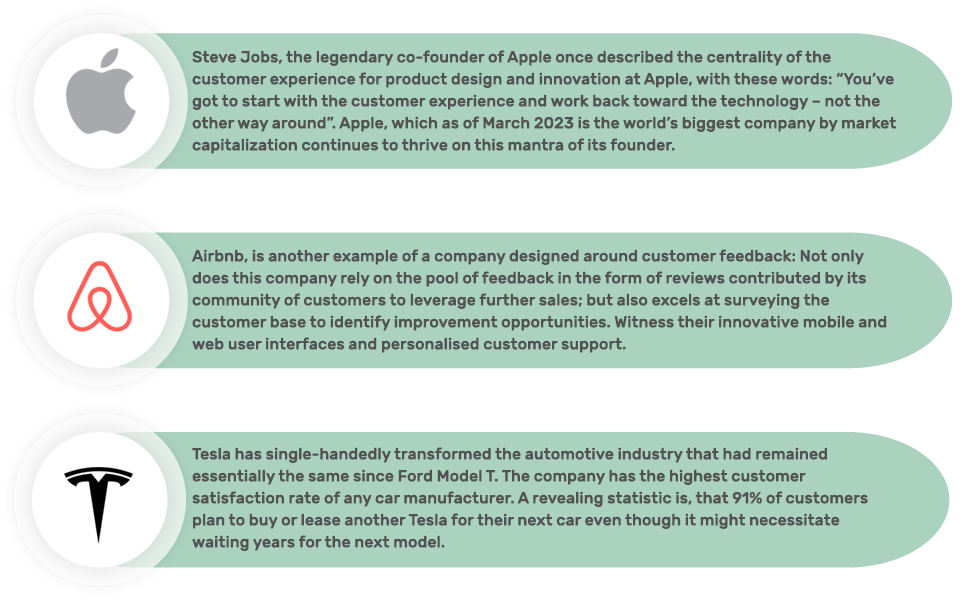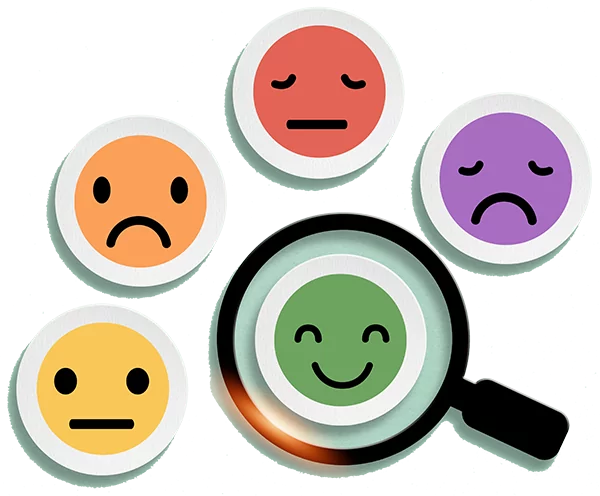
There is broad consensus on what the term entails, though formulations differ. The following seems to capture the essence:
Modern businesses are aware that “customer perception of gained value” is a function of more than the qualities of a delivered product or service. It is beyond than price or merit relative to competitor offerings (though these factors are important). Overall customer experience spanning communication, interaction and customer service quality is a significant part of the equation. And of course, branding and marketing as well as fashions and social trends cannot be underestimated as perception shaping dynamics.
The tenet of customer satisfaction as a goal is simple: Businesses that understand and serve their customers better than their competitors retain their customers. Loyal customers continue to consume products of these businesses and act as willing marketing evangelists, providing a conduit for attracting new customers. This results in an increase of stakeholder (not always shareholder!) value.
Having established the pedigree and importance of the concept, we should expect all businesses to be oriented towards the principle of delivering customer satisfaction. Indeed there are many organisations that have understood customer experience as the basis of customer attraction and retention, and by extension growth and stakeholder value. In such customer oriented organisations, policies, business plans, processes and procedures are fully aligned with the goal of achieving customer satisfaction.
However, this remains far from universal. Many organisations remain less customer focused; some by design, most through not having fully embraced the transition to a customer oriented approach. How and why is this so, and if some organisations are able to function effectively without being customer oriented, why should they worry?
The reason is change, or rather the change in the nature of change.
Until relatively recently, attaining customer satisfaction was a high threshold – low maintenance quest for organisations: Establishing a customer base through providing the right product and services was not easy, but once achieved relatively easily sustainable. This was a goal post that was, if not stationary, at least moving at a constant speed.
This situation is altering rapidly. Intensifying competition – but now from unexpected and seemingly distant threats; rapid innovation and disruptive technologies; geopolitical forces supporting and opposing the outreach of supply chains; market fragmentation; demographic trends; the social media revolution and the shift in working and living habits post-pandemic are conspiring to remove any semblance of customer constancy or long-term predictability.
In this world, customer-base is perhaps the only measure of value, and customer satisfaction a fast-paced chase.
Customer oriented companies and organisations have the necessary sensory apparatus to identify customer trends; the nimbleness to respond to shifts in expectations and perceptions; and the suppleness to reinvent business processes for their customers. Such organisations, characterised as having customer orientation skills, are prepared for this storm. For others the prognostic is not bright, as attested by frequent news of the sudden demise of once renowned corporate names.
Now, the question is; how customer oriented is your organisation and does it have the necessary customer orientation skills and customer focus to survive and prosper?
But, as managerial opinion called on to respond to this question is from “within the box”, we can guess the answer to be something like “fully”. And it is this gap between organisational self-conviction and customer perceived actuality, into which organisations risk disappearing. So let’s rephrase this most urgent question: Are you customer oriented?
Identifying a customer-oriented organisation
Unfortunately, objectively measuring how customer-oriented an organisation is, is not a simple task. Frameworks and methodologies for measuring organisational processes against various customer satisfaction/experience maturity models exist, and might be worth putting to use, but are sure to consume time and substantial organisational resources.
The good news is that there are reliable indicators which can be less resource intensively utilised, to provide a reasonably detailed profile of organisations in this respect.
Here we will take a look at seven of the most prominent indicators that can be used to gauge just how customer-oriented your organisation is.
1. Customer service is personalised
Your customer service is personalised if; beyond the basics of a customer service infrastructure, your support and communication with customers is performed in a mode dictated by their particular needs and preferences.
The view that customer individuality and uniqueness is not a constraint but an opportunity is firmly established in both your mind-set and practices.
Check-list:
- You leverage insight on each individual customer. You ensure this insight is up-to-date and reflects the shifts in customer outlook. For this, you use customer data and analytics, but you also emphasise one-to-one communication.
- Beyond a catalogue of products and services; you provide a comprehensive set of recommendations, packages, incentives, custom products and services, financial arrangements, support, community involvement and similar; all unique to the individual customer.
- Importantly, you customise the actual channel, mode and volume of communication to fit perfectly with customer preferences, wishes and constraints.
- Not only your customer-facing processes, but all business processes involved in delivering customer value are designed to leverage your customer insight.
Case in Point:
Jeff Bezos formulates his take on embracing customer individuality and dynamism in these words: 'One thing I love about customers, is that they are divinely discontent.
People have a voracious appetite for a better way, and yesterday’s ‘wow’ quickly becomes today’s ‘ordinary.' Amazon, Bezos’ brainchild, leverages customer data to provide highly customized product recommendations based on customer purchase history and browsing habits revolutionised the way consumers shop.

Netflix utilises AI to generate viewing recommendations based on viewer habits. This approach has profoundly changed the world of entertainment, along with viewer expectations of what defines a streaming service.
Another great example is Zappos, an online shoe and clothing retailer renowned for exceptional customer orientation skills. Zappos confounded many of its competitors and permanently shifted customer expectations by providing 365-day return policies, free shipping in both directions and 24/7 customer service. This company puts customer service staff through a training curriculum designed to develop the skills necessary to be able to identify customer requirements and respond with suitable recommendations based on their needs and preferences.
Quiz your organisation:
Hint: The answer for a truly customer oriented company consists of a full listing of customers and their preferred communication channels.
2. Customer feedback is proactively sought and acted on
You proactively seek and act on customer feedback if; on the one hand you maintain suitable communication channels at all times to receive feedback, incentivise the customer to provide feedback and demonstrably act on feedback; and on the other hand, purposefully act to collect feedback.
Check-list:
- You actively maintain customised channels of communication with your customers so as to receive their ideas, suggestions, comments and complaints; and provide timely, courteous and informative responses.
- It is understood within your organisation that the lack of feedback is more dangerous than negative feedback. Feedback volume and profile is monitored to track the level of communication with customers.
- You incentivise your customers by attentiveness to their feedback and demonstration of action taken by you in response. Not only do you respond to specific cases, but leverage customer feedback to identify business improvement opportunities, increase your understanding of customer value perception, and expectations regarding your products and services.
- Customer initiated communication is complemented by frequent and routine reach-out through well designed, incentivised, targeted and scheduled surveys and focus group studies. The insight gained is channelled in to improving the customer experience.
Case in point:

Quiz your organisation:
Hint: There should be explicit mechanisms for eliciting, collecting and measuring feedback. Your organisation should be able to demonstrate a traceable relationship of this feedback with innovations shared with customers.
3. Customer relations are consistently healthy
Your customer relations are consistently healthy when; you have dedicated organisational resources to systematically managing the customer interaction and feedback cycle through data analytics and proactively maintaining relationships through customised service. You can identify the value of particular customers to you, and a corresponding understanding of their needs and preferences.
Check-list:
- All of your customer information is up to date and accurate at all times, including the history of your relationships with the customer. You are able to analyse trends and identify potential opportunities or threats regarding your customer relationships and act upon this information. You know your customers and can anticipate their needs.
- You have a workforce selected and trained to understand and adhere to your view of customers as the lifeblood of your organisation. You measure and evaluate your workforce on this basis.
- You are able to categorise customers according to marketing objectives and appraise the value of each customer in relation to organisational objectives.
- Customer retention strategies including communication plans, loyalty programs and promotions are in-place. You make sure to display your appreciation to all of your customers.
- You have strategies such as referral awarding that make use of your customer base to generate new customers.
- Your customers are supported by the most appropriate means (including one-on-one guidance, AI tools and community involvement).
- You leverage your customer relationships through routine market segment focused marketing campaigns.
- Your customer interaction is honest.
Case in point:
Harley-Davidson, the motorcycle brand built around the idea of “freedom” has a strong and loyal customer following sharing the same values. Harley-Davidson hosts events and trips that regularly bring its community of customers together and operates loyalty programs rewarding customers demonstrating what a truly customer oriented approach can achieve.
American Express is a financial services company that has built a strong customer following by virtue of a constant and consistent customer focus. The AmEx credit card is the product most connected with the company in the public imagination and associated with the famous slogan “don’t leave home without it”. It is estimated that there are 29 Visa cards and 17 MasterCard’s for every one AmEx card. American Express has made this into a virtue, a mark of prestige and privilege for AmEx customers. The company has an impressive loyalty program that rewards customers for making more purchases where Amex is used. Loyal customers ensure American Express continues to be a strong global payment system organisation that continues to increase customer loyalty and revenue.
Quiz your organisation:
Hint: For a customer or group of customers, your organisation should be able to produce metrics quantifying the change in the level of relationships. Your organisation should be able to demonstrate initiatives to develop relationships and the results of these initiatives.
4. Customer satisfaction is aggressively pursued

Customer satisfaction is aggressively pursued if; you understand that customer satisfaction is the fundamental indicator for a customer-oriented company.
You develop organisation specific measures to gauge customer perceptions and expectations, and continuously work to develop institutionalized solutions that will ensure customer satisfaction, always trying for new heights.
A very significant part of your workforce, departmental, managerial and overall performance is measured against customer satisfaction.
Check-list:
- You explicitly measure customer satisfaction. For this purpose, you monitor customer feedback and conduct surveys using systematic methods (such as Net Promoter Score) and take deliberate action to increase customer satisfaction by using various tools such as mystery shopping applications.
- Solutions are institutionalised and innovative. You plan ways to increase customer satisfaction, anticipate outcomes and measure results. You have the organisational will to innovate and try unconventional approaches to gain and retain customer trust.
Case in point:
The Ritz-Carlton is a luxury hotel chain that has built a reputation as one of the world’s top hospitality providers through exceptional customer service. Ritz-Carlton perpetuates its customer focused corporate culture through training programmes for its 24/7 guest service and assistance teams. These training programmes immerse trainees in the company’s customer focused philosophy and ensure a customer oriented approach guiding all guest interaction. Through such training, employees are guided to consistently anticipate and exceed customer expectations.
Toyota is an automobile manufacturer, for which commitment to quality and customer focus is the hallmark of its organisational culture. The company’s products are designed solely with customers in mind and Toyota’s dedicated customer service team is renowned for being second to none. This customer-centric focus has helped Toyota build a reputation as one of the most reliable and high-quality automobile manufacturers in the world.
Quiz your organisation:
Hint: The implementation of these measures must be demonstrable as part of the information system. Data trends should make apparent the relation between organisational customer satisfaction targets and customer retention/promotion levels.
5. Customer problems are solved close to source
Customer problems are solved close to source if; you leverage predictive tools to pre-empt problems or failing that, solving them before they become a major issue. This entails monitoring and predicting issues and rapid response to issues. You identify the level at which solutions are found and act on this data to improve the level at which problems are solved.
Check-list:
- You have institutionalised solutions to emerging customer issues. You have pre-designed responses that can be applied quickly and effectively to counter problems. These may include measures from offering unconditional returns/exchanges up to the provision of ongoing support and guidance to assist customers solve problems on their own.
- You track the Customer Complaint Trend indicator with the purpose of averting complaints, by taking predictive measures in areas identified as high risk.
Case in point:
Delta Airlines is renowned for exceptional customer service. The company has dedicated customer service teams to assist customers with ongoing issues. Supporting this service, Delta Airlines has a proactive problem resolution approach that includes monitoring flight schedules and identifying/addressing potential issues that may cause delays or cancellations. Delta’s CSM reaches out to assist potential and current passengers, offering assistance and flight rebooking as required.
Quiz your organisation:
Hint: Your organisation has leveraged AI, and is able to resolve above 80% of issues at source.
6. Organisational culture is customer-biased
Your organisational culture is customer focused if; you fully understand the advantages of putting the customer at the centre of all thinking and action. You go beyond simply knowing what your customers want, and try to develop a deep understanding of them and the context of their needs. Your source of ideas and inspiration to innovate is primarily your customers. Your organisation is driven by customer expectations. Strategies and policies are customer oriented. Key performance indicators and HR incentive systems are defined in view of customer satisfaction levels.
Check-list:
- Your organisation measures improvement initiatives in terms of projected increase in customer satisfaction.
- You prioritise customer related data collection over all other categories, and value data according to the depth of analysis it affords of the customer.
- Your training schemes emphasise understanding, communicating with, and serving your customers.
Case in point:
Amazon’s customer oriented approach permeates all aspects of the company, from customer service teams to product development. The company CEO Jeff Bezos once described customers as, “always beautifully, wonderfully dissatisfied, even when they report being happy and business is great. Even when they don’t yet know it, customers want something better, and your desire to delight customers will drive you to invent on their behalf.” This perfectly illustrates the principle of customer focused organisation.
Southwest Airlines has a unique customer oriented approach that emphasises teamwork, fun and dedication to serving customers. The company mission statement is simply “Dedication to the highest quality of customer service delivered with a sense of warmth, friendliness, individual pride, and company Spirit”. This translates into exceptional customer service and helps the company build a loyal customer group. It is the major reason why the economic crisis resulting from the Covid-19 pandemic, that put many airlines in crisis, bypassed the company which remains one of the strongest airlines in the world.
Quiz your organisation:
Hint: Your HR department can produce quantitative data in response to this question.
7. Relationships are for ever
Relationships are for ever (for your organisation) if; you comprehend the importance of relationships in maintaining your customer base. You understand that the cost of new customer acquisition is a magnitude greater than preserving existing customers, and the ultimate survival of your organisation depends on customer retention.
Check-list:

- You emphasise repeat custom. You identify this repetition as a deepening and strengthening of customer relationships. You understand the positive impact of repeat custom on organisational sustainment.
- Your relationships begin before your customer becomes a customer! You are able to collect sufficient information about potential customers, and to come up with offers to attract them.
- You explicitly track, monitor and benchmark repeat custom, and implement measures to ensure the continuation of customer involvement.
- You are able to identify customers with high lifetime value for your organisation. You know how to classify and profile customers with high lifetime potential, and have put in place active measures to acquire more of them.
- Loyalty spans products and periods: You systematically plan the growth/reinforcement of your brand and budget your investment in loyalty. Loyalty to your products is defined in terms of repeat custom.
- A critical (but not the sole) component of customer satisfaction, is identified by your organisation as product/service quality.
Case in point:
Exemplary organisations are not necessarily new. Kongō Gumi, a family carpentry company founded in Japan in 578 AD by a Korean migrant, and which operated until 2006 as an independent organisation founded, maintained, repaired and rebuilt the Shitennō-ji temple for over fourteen centuries.
Yoshisada Kongō the 32nd head of the company during the Meiji period, emphasised the importance of customer focused relationship management in the longevity of the company, laying down down the precepts “Listen to what the customer says”, “Treat customers with respect” and “Submit the cheapest and most honest estimate”.
Quiz your organisation:
Hint: Your organisation should be able to offer-up this information across business segments and products, together with a measure of the number of repetitions, frequency and predicted repeat custom interval.
Conclusion
In conclusion it is perhaps in order to refer to Peter Drucker, one of the most important theorists of management science, on the subject: Drucker remarks; “Culture eats the strategy as breakfast”. In essence this means that if your customer focus strategy is not compatible with your organisational culture, even the best strategy will not lead you to success. Organisational culture is the shared values, beliefs, behaviours, standards and norms of an organization. The culture of an organization is shaped by the behaviour and interactions of its employees. If your company's goal is to maximise customer satisfaction, then you have to set out to purposely transform that culture before you invest in other initiatives.

